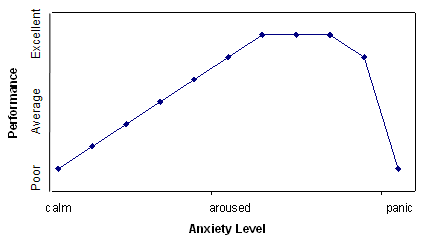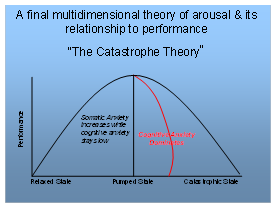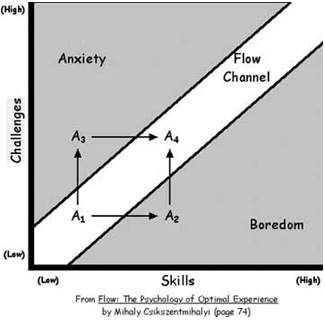Anxiety and Performance
Anxiety is most often considered a problem if it occurs when there is no real threat or when the anxiety response is disproportionate to the threat being faced. However, when there is a real situation or stressor to deal with, the anxiety level might actually be appropriate. Appropriate levels of anxiety activate the organism to prepare and act. Therefore, in some situations, extreme levels of activation may be appropriate. Appropriate levels of anxiety can facilitate a person to prepare well for an exam through motivating them to etch out time to study while having them alert enough to study productively, stay focused and remember well.
Appropriate levels of anxiety can also act as a gauge to clarify how threatening or dangerous a situation might actually be. In this context extremely high levels of anxiety may actually represent a realistic emotional response to a very threatening and dangerous situation. In many instances, people with anxiety disorders will often worry about appropriate levels of anxiety presuming it is either inappropriate or unproductive. They may find it difficult to differentiate between those times when they may feel anxious for a legitimate reason and those times when their anxiety may be disproportionate or unnecessary. Often this is because there is a fear that the anxiety may become uncontrollable.
Specifically, the daily role of the fight or flight response is to increase our mental alertness to deal effectively with the types of life events and stressors we often encounter in our day, like taking an exam, dealing with conflict at work, driving in peak hour traffic, preparing a presentation, setting boundaries in relationships and a range of other things. Anxiety, at the right level, is vitally important as it activates us to perform well and meet the demands of life events and stressors because it increases; our alertness, our ability to think clearly and our ability to respond optimally to such things.
Because some level of anxiety is required for effective responses to life events and stressors, too little anxiety would make life events and stressors too difficult to deal with, because we would not be motivated to prepare and we would not be activated to perform at a level adequate to meet the relevant demands. On the other hand though, too much anxiety will decrease our capacity to deal with such things optimally.
This relationship between performance and the right level of anxiety explained above is illustrated below.
The Relationship between Anxiety and Performance
As anxiety levels rise, performance increases due to the arousal of the mind and body. However once anxiety reaches excessive levels, performance decreases dramatically. Where the point of excessive anxiety is depends on the stressor needing to be faced at the time and other personal qualities and attributes of the individual experiencing the anxiety.
The Catastrophe Theory
The Psychology of Optimum Experience
The model in the “Catastrophe Theory” image above identifies an individual’s mental state during a given life experience. The three realms of possible metal state in relation to the organisms level of activation in dealing with presenting stressors are; Boredom, Flow Channel, and Anxiety.
Csikszentmihalyi’s definition of flow is based upon the balance between skills and challenges. The models of flow try to account for all possible combinations of high and low skills and challenges that can result in the broad spectrum of responses between heightened levels of anxiety and more subdued levels of boredom.
Click here to watch Mihaly Csikszentmihalyi’s TED Talks video on Flow (19 minutes)
Anxiety is identified when a person perceives the challenge (or threat) as being high while their skills to deal with such a challenge (or threat) is perceived to be low. Thereby the more challenging or threatening the stressor is and the lower the skill level is in being able to deal with it the higher the level of anxiety will be. Boredom is identified as a perception of being high skilled but with a low level of challenge or threat from the stressors. Boredom can be defined as a state of relatively low arousal and dissatisfaction, which is attributed to an inadequately stimulating situation (Mikulas and Vodanovich, 1993).
A key feature of flow is when an activity features an appropriate balance between the stressor challenge and the skill level required from the person to meet the stressor challenge effectively. If the challenge or threat of a situation is perceived to be too great for the person’s skills then they will eventually become frustrated, lose interest, discontinue from being in flow and instead move into a relative degree of anxiety.
This may eventuate into becoming too anxious and quite fearful if the challenge or threat is too great in comparison to their skills in dealing with it and if the consequences of failing to deal with it are considered significant. Flow will also cease if the challenge of the activity is too low and is too easy whereby it stops being interesting and boredom results.





Pingback: AIPC Article Library » Counsellors vs Workplace Harassment